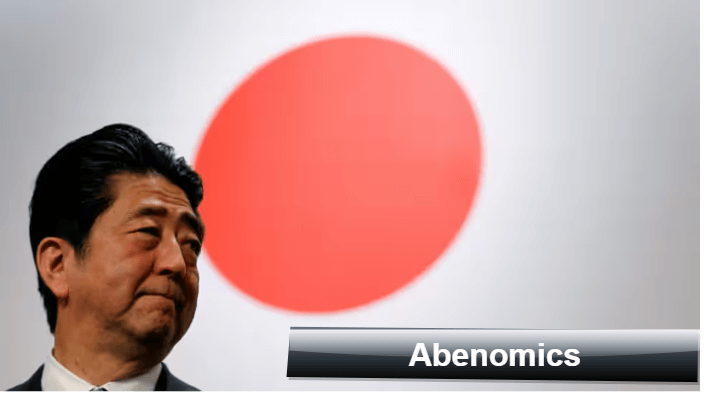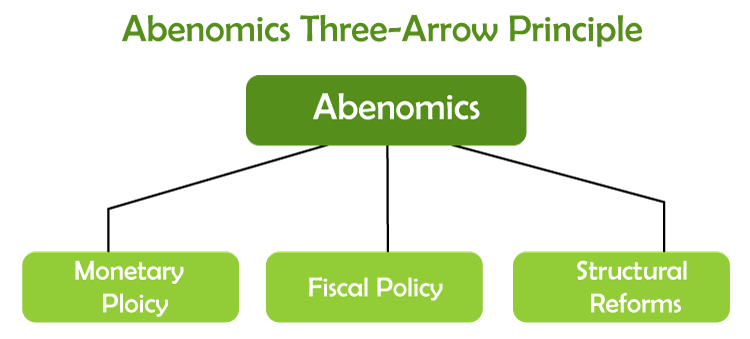AbenomicsWhat is Abenomics?Abenomics is a set of economic and social policies established and enacted by former Japanese Prime Minister Shinzo Abe in order to revitalize the country's economy. He put forth these reforms shortly after taking government for the second time in 2012. 
In order to aid the nation in recovering from the 2008 global financial crisis, he came up with a three-arrow economic plan that included fiscal policy, monetary policy, and structural improvements. It also entailed other objectives, such as raising the nation's money supply, increasing government spending, and implementing reforms to raise the competitiveness of the Japanese economy. The phrase Abenomics is a combination of the words Abe and Economic and is one of the political neologisms that refers to the economic policies associated with certain leaders, such as Reaganomics or Clintonomics. Overview of Abenomics
How does Abenomics work?Abenomics was a successful economic policy implemented by Abe in Japan in 2012. However, it was still recovering from the 2008 global financial crisis at the time. As a result, the country's GDP was negative, and Japan's exports were also declining, which had a detrimental effect on the country's economy. So, in order to bring the country's economy out of a protracted period of poor growth, he wanted to increase inflation to 2% and reduce deflation. Abe had to figure out a method to balance the loopholes with effective economic policies since people had modest spending habits; when a population doesn't spend money wisely, businesses and sectors suffer, which affects the economy's overall financial well-being. The essence of Abenomics goes beyond just economic growth. It also includes social improvements that need to be ingrained in society, as well as digitization. Abe devised a three-arrow economic plan to stimulate the economy of the country, which included the following:
The nation's economic growth was positively impacted by these policies, which led to the following outcomes:
Why was Abenomics vital to the Japanese economy?In 1997, the Japanese government increased consumption tax rates from 3% to 5%, worsening the already-existing recession and deflating the economy. In order to balance its budget, the government increased the consumption tax in 1997. As a result, consumption fell, which resulted in a 4.5 trillion yen drop in government revenue. In 1996, the nation's GDP grew by 3%, but the tax increase caused the economy to enter a recession. For the majority of the five years following the tax increase, the nominal GDP growth rate was below zero. Japan's average yearly wages increased between 1992 and 1997; however, incomes started to fall once the consumption tax increase took effect in 1997. Following 1997, wage declines outpaced those of nominal GDP. It was, therefore, necessary to develop a new, more comprehensive policy. Objectives of AbenomicsThe goals for framing Abenomics were:
Three Arrows of Abenomics
Fiscal PolicyBecause of the Abenomics strategy, the government invested trillions of yen in infrastructure, including flyovers, buildings, and motorways. As a result, the consumption tax was doubled. However, this initiative also resulted in a huge increase in employment. Additionally, the rise in employment allowed people to increase their earnings and spend more on goods and services. As a result, commerce and trade increased, assisting businesses and industries and advancing the economy. A fiscal policy also helped with the following objectives:
Monetary PolicyIt includes a number of quantitative easing programs aimed at increasing liquidity in the economy. However, in the 1990s, Japan's economy slowed down as a result of the collapse of the asset and real estate price bubbles. In addition, national banks made loans without verifying the borrowers' qualifications. Most of the borrowers couldn't make their payments and ended up defaulting, which created issues for the banking system. Banks and other financial organizations started to implement stricter rules as a result of their prior experiences. It, therefore, made it more challenging for the populace to borrow money. In addition, nobody wanted to borrow money since the interest rates were too high. Furthermore, since they were not heavy spenders, people rarely considered borrowing money. Abe suggested lowering interest rates to a possible number in order to maintain the financial equilibrium. In order to encourage lending and investment, the Bank of Japan set rates low at minus 0.1% despite concerns about the impending collapse of the financial system. In order to continue the cycle of borrowing and spending, the government started to print more money. Additionally, it increased the amount spent on goods and services, which raised the price of those things. All of this made the inflation rate near the target level. Additionally, it increased exports and inflation. Structural ReformsIn addition to lower spending and borrowing issues, a labour shortage also had an impact on the economy. Moreover, the birth rate has also fallen sharply over the past few years. It was therefore anticipated that the country would experience a prolonged period of population decline. Abe put forth social reforms to tackle the labour shortage problem based on expected population growth. Additionally, he unveiled Abenomics 2.0, a plan to increase the birth rate while enhancing pensions and social security for the elderly. In order to encourage people to start families, Abe also proposed incentive and reward schemes. To achieve this objective, he made investments in childcare services and educational reforms. He encouraged more women to enter the workforce and removed the spousal tax as part of his womenomics strategy. Other initiatives included:
Has Abenomics worked?Like every major Japanese economic strategy since the bubble burst, Abenomics has had its advantages and drawbacks. The country has achieved its inflation goals, and its unemployment rate has become more than 2% lower than it was when Abe took office for the second time. Similarly, nominal GDP had risen, and corporate pre-tax earnings and tax revenues had both climbed significantly. Abenomics led to a huge rise in job prospects, bringing the unemployment rate to less than 3%. The measures were successful in boosting Japan's economy. Additionally, all three of these metrics-the GDP, tax revenues, and inflation-rose. While the acceleration rate wasn't as quick as Abe had planned, it was still sufficient to put the economy back on track. The efforts were effective in easing the stringent large-scale monetary criteria of the Bank of Japan. The monetary strategy led to significant asset purchases and yield curve control, which set examples for other central banks. The simplicity of financial transactions benefitted the equities market as well. Japanese businesses also relied increasingly on exports for revenue, which boosted economic expansion. Abe stepped down as Prime Minister in September 2020, and his successor, Yoshihide Suga, carried on the legacy and continued Abenomics. Many experts commended Abe's efforts and gave credit for strengthening the Japanese economy. Additionally, they claimed that his measures assisted the nation in dealing with the economic uncertainty brought on by the coronavirus pandemic as well. Despite Abenomics, the expected expansion has been hampered by the ageing population, the country's economic problems, and global economic concerns. The nation's most important economic issue-a fast ageing population-has taken centre stage, and the nation's periods of prosperity have occasionally been interrupted by forces of the global economy.
Next TopicAccount Number
|
 For Videos Join Our Youtube Channel: Join Now
For Videos Join Our Youtube Channel: Join Now
Feedback
- Send your Feedback to [email protected]
Help Others, Please Share









